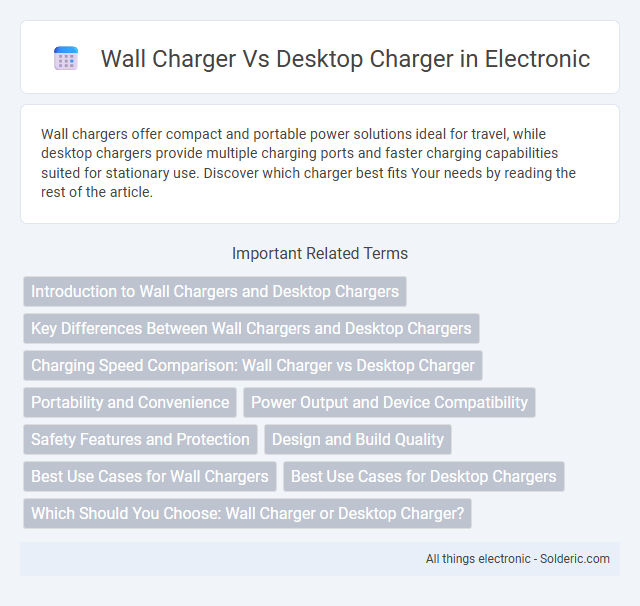Wall chargers offer compact and portable power solutions ideal for travel, while desktop chargers provide multiple charging ports and faster charging capabilities suited for stationary use. Discover which charger best fits Your needs by reading the rest of the article.
Comparison Table
| Feature | Wall Charger | Desktop Charger |
|---|---|---|
| Primary Use | Charging devices via wall outlets | Charging and docking devices on a desktop |
| Portability | Compact, easy to carry | Bulkier, less portable |
| Charging Speed | Typically faster with high wattage models | Varies; often slower due to multiple device support |
| Power Source | Direct AC wall outlet | AC outlet or USB power input |
| Device Support | Usually single device | Can support multiple devices simultaneously |
| Design | Minimalist, plugs directly into wall | Stationary, often includes USB ports and stands |
| Common Uses | Smartphones, tablets, small electronics | Smartphones, smartwatches, earbuds, multiple gadgets |
Introduction to Wall Chargers and Desktop Chargers
Wall chargers are compact, portable power adapters designed to plug directly into electrical outlets, ideal for on-the-go charging of smartphones, tablets, and other electronic devices. Desktop chargers offer a stationary charging solution with multiple ports and higher power output, suitable for organizing and charging several devices simultaneously at home or office. Both charger types vary in power ratings, compatibility, and convenience, catering to different user needs and environments.
Key Differences Between Wall Chargers and Desktop Chargers
Wall chargers typically connect directly to power outlets and are compact, designed for portable use with devices like smartphones and tablets, supporting faster charging through high-wattage outputs. Desktop chargers offer multiple charging ports and a stable base, ideal for simultaneously powering several devices such as phones, tablets, and accessories while reducing cable clutter. The key difference lies in portability and charging capacity, with wall chargers excelling in mobility and desktop chargers providing convenience for stationary, multi-device setups.
Charging Speed Comparison: Wall Charger vs Desktop Charger
Wall chargers typically offer faster charging speeds compared to desktop chargers due to higher wattage and direct power delivery capabilities. Desktop chargers often have lower power output, resulting in slower charging times for your devices. Choosing a wall charger ensures more efficient energy transfer and reduced overall charging duration.
Portability and Convenience
Wall chargers offer superior portability due to their compact size and lightweight design, making them ideal for travel and on-the-go use. Desktop chargers provide greater convenience with multiple charging ports and stable placement but are less portable and typically suited for stationary use. Choosing between them depends on whether mobility or multi-device charging efficiency is the priority.
Power Output and Device Compatibility
Wall chargers typically offer higher power output, supporting fast charging technologies up to 30W or more, making them ideal for smartphones and tablets. Desktop chargers often provide multiple ports with moderate power output, allowing simultaneous charging of various devices like phones, tablets, and laptops. Your choice depends on whether you prioritize single-device rapid charging or versatility in device compatibility.
Safety Features and Protection
Wall chargers often include advanced safety features like overcurrent protection, short-circuit prevention, and temperature control to safeguard your devices during charging. Desktop chargers typically offer similar protections but with enhanced multi-device safety protocols and stable power distribution for simultaneous charging. Choosing a charger with certified safety standards ensures your devices are protected from electrical hazards and battery damage.
Design and Build Quality
Wall chargers typically feature a compact, lightweight design optimized for portability and easy plug-in use, often housed in durable plastic with foldable prongs for travel convenience. Desktop chargers generally offer a larger, sturdier build designed for stability on flat surfaces, incorporating additional features like multiple ports and enhanced cooling mechanisms for prolonged use. Both charger types prioritize high-quality materials, but desktop chargers emphasize robustness and functionality, while wall chargers focus on minimalism and ease of transport.
Best Use Cases for Wall Chargers
Wall chargers excel in providing fast and efficient charging for smartphones and tablets, especially in environments with limited space or frequent mobility needs. Ideal for home, office, and travel scenarios, they plug directly into power outlets, eliminating cable clutter and maximizing portability. These chargers are optimized for quick power delivery, making them essential for users requiring rapid device replenishment and convenience.
Best Use Cases for Desktop Chargers
Desktop chargers excel in environments where multiple devices need simultaneous charging, such as offices, homes, or shared workspaces, providing organized and efficient power distribution. Their larger size and higher power output make them ideal for quickly charging tablets, laptops, and smartphones without occupying wall outlets. Your convenience increases as desktop chargers often feature multiple ports and enhanced safety features, supporting continuous device use and reducing cable clutter.
Which Should You Choose: Wall Charger or Desktop Charger?
Choosing between a wall charger and a desktop charger depends on your charging habits and device compatibility. Wall chargers are compact, offering portability and fast charging through higher wattage outputs, ideal for on-the-go use with smartphones and tablets. Desktop chargers provide multiple charging ports and a stable platform, making them suitable for home or office environments where charging several devices simultaneously is a priority.
Wall charger vs Desktop charger Infographic

 solderic.com
solderic.com